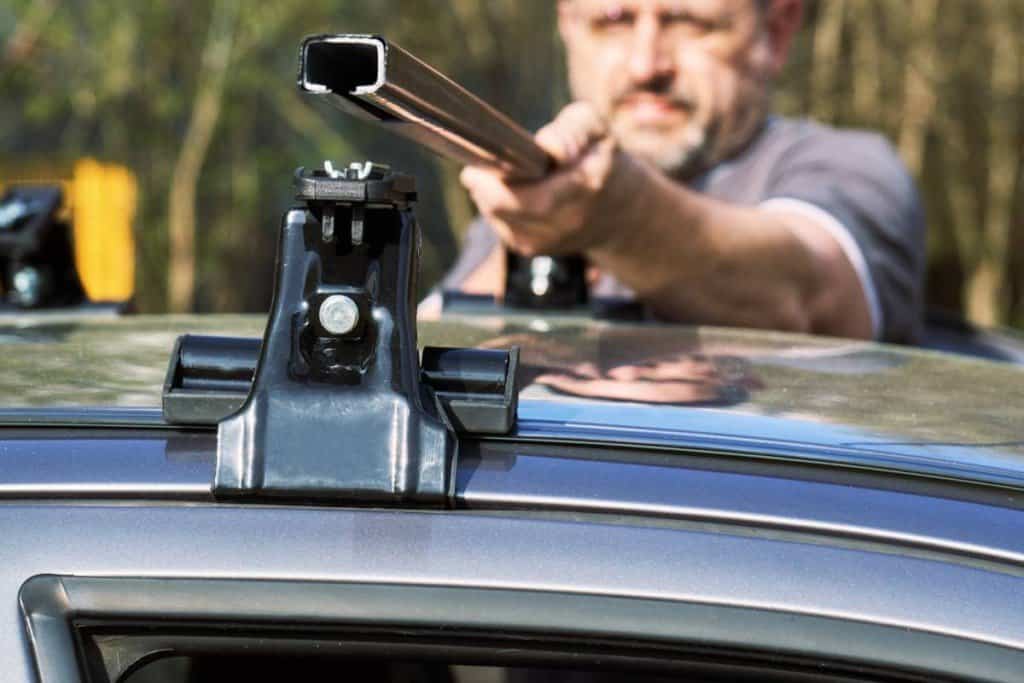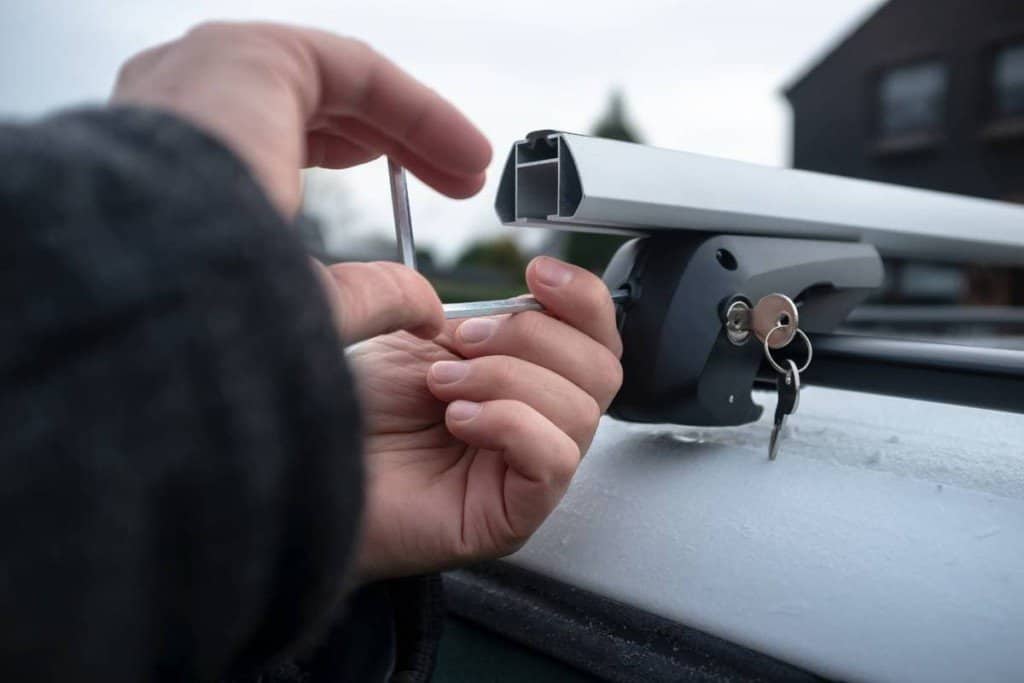Do roof racks make noise? I bet you never even thought about that before you installed one. But now that you have, you’re probably wondering why your roof rack is so loud and how you can fix it.
The cheapest way to fix roof rack noise is to wrap an elastic rope (in a spiral) around the front crossbar. This will help to disperse the airflow and reduce the noise. You can also replace the roof racks with an aerodynamic option, install wind fairing, or get rid of the load bars altogether.
This article will explore each of these methods in more detail so that you can choose the best option for your needs. I will also explore how you can make your own wind fairing out of a pool noodle. Let’s get started!

Why Do Roof Racks Make Noise?
Roof racks are a great way to transport oversized items that wouldn’t fit inside your car. They are usually made of metal and have crossbars that attach to the roof of your vehicle. You can then attach various items to the roof rack, such as bikes, kayaks, or luggage.
So, why do roof racks make noise?
One of the reasons that roof racks make noise is that they are not very aerodynamic. The metal crossbars disrupt the airflow over your car, creating turbulence and noise. Also, any accessories you have attached to the roof rack will also add to the noise.
There are two main types of turbulence: laminar and turbulent. Laminar flow is when the air flows smoothly over the object, while turbulent flow is when the air hits the object and swirls around it. Most roof racks will create turbulent flow, which is why they are so loud.
However, the shape of the roof rack can also create turbulence. If the roof rack is too wide, it will catch more air and create more turbulence. Additionally, if the roof rack is not level with the car’s roof, it will also create turbulence.
So, how can you reduce the noise from your roof rack? Let’s look at some options.

Ways to Stop Roof Racks From Making Noise
1. Wrap the Roof Rack With an Elastic Rope
One of the cheapest ways to fix roof rack noise is to wrap an elastic rope in a spiral around the front crossbar. This will help to disperse the airflow and reduce the noise. You can find elastic rope at most hardware stores, which is usually relatively cheap.
To do this, measure the length of the front crossbar. Cut a piece of elastic rope longer than the measurement you just took. Then tie one end of the rope to the front crossbar and wrap it around in a spiral.
As you wrap the rope around, pull it tight so it is snug against the crossbar. Once you reach the end of the bar, tie it off and cut any excess.
This method is not foolproof, but it will help to reduce the noise from your roof rack. It is also very cheap and easy to pull off.
2. Replace the Roof Racks With an Aerodynamic Option
If you want a more permanent solution, you can replace the roof racks with an aerodynamic option. There are many types of aerodynamic roof racks on the market, so be sure to research to find the best one for your needs.
Some things to look for in an aerodynamic roof rack include:
- The shape of the Roof Rack. A boxy roof rack will create more turbulence than a sleek, aerodynamic one. If you are looking for an aerodynamic roof rack, choose one with a teardrop shape. This will help to reduce the amount of turbulence and noise.
- The Material of the Roof Rack. Another thing to consider is the material of the roof rack. Steel roof racks are not very aerodynamic, so they will create more noise than a plastic or fiberglass option. If you are looking for an aerodynamic roof rack, be sure to choose one that is made of aluminum or fiberglass.
Also, if you plan to attach anything to the roof rack, choose aerodynamic attachments. For example, aerodynamic bike racks will connect to the roof rack and reduce the amount of noise compared to other setups.
3. Keep Your Roof Rack Level
This might not seem like a big deal, but it can actually make a big difference. If your roof rack is not level with the roof of your car, it will create more turbulence that will result in more noise.
I learned this the hard way. I had my aerodynamic roof rack installed, but I did not level it with the roof of my car. As a result, it created a lot of turbulence and noise. I had to go back and adjust it so that it was level with the roof. Once I did that, the noise was reduced significantly.
4. Install a Roof Rack Wind Fairing
Another option is to install a roof rack wind fairing. A wind fairing is a piece of material that helps to deflect the wind away from the roof rack. This will help to reduce the amount of turbulence and noise.
There are many different types of wind fairings on the market, so be sure to research to find the best one for your needs. Some wind fairings are made of plastic or fiberglass, while others are made of metal.
Also, some wind fairings attach to the roof rack with screws, while others attach with velcro. Be sure to choose a wind fairing that will be easy for you to install and remove.
With these things in mind, you should be able to find a wind fairing that will work for your situation.
5. Pad the Roof Racks
If you are looking for a temporary solution, you can pad the roof racks. This will help to reduce the amount of noise and vibration. It is also very cheap and easy to do.
One way to pad the roof racks is to use foam pipe insulation. You can find this at most hardware stores.
To do this, you should:
- Measure the circumference of the front crossbar.
- Cut a piece of foam pipe insulation that is exactly the same size as the circumference of the crossbar.
- Measure the circumference of the rear crossbar.
- Cut another piece of foam pipe insulation for it.
- Take the two pieces of foam pipe insulation and put them over the front and rear crossbars. Make sure that the ends of the foam pipe insulation are even with each other.
- Take duct tape or zip ties and attach the two pieces of foam pipe insulation to their respective crossbars. This will help keep them in place.
6. Check the Rack to Roof Connection
Another thing that you can do is to check the fasteners that are holding your roof rack in place. Over time, these straps can become loose, and this can cause the rack to move around and make noise.
To check if the rack is still snugly seated on the roof, find the fastening knob on the front of the rack. This is usually located near the top of the rack. Then, turn the knob clockwise to tighten the rack assembly.
Next, take a look at the rear of the rack. There should be two knobbed screws that hold the rear of the rack in place. If these screws are loose, you will need to tighten them.
7. Replace the Load Bars With Edge Bars
If you want a more permanent solution, you can replace the load bars on your roof rack with edge bars. Edge bars are made of aluminum and designed to reduce noise and vibration.
Here is a step-by-step process for removing the load bars and installing edge bars:
- Remove the front and rear crossbars from the rack.
- Use a screwdriver to remove the load bar end caps.
- Use a wrench to loosen the bolts holding the load bars in place.
- Remove the load bars from the rack.
- Take the edge bars and install them in place of the load bars. Make sure you use the same bolts to secure the edge bars.
If you follow these steps, you should be able to reduce the amount of noise and vibration coming from your roof rack.
How To Make Your Own Wind Fairing From a Pool Noodle
If you want to reduce the noise coming from your roof rack, you can make your own wind fairing from a pool noodle.
Here is how to do it:
- Cut a pool noodle in half.
- Take the pool noodle and put it over the front crossbar of the rack. Make sure that the crack is facing the back.
- Then, take another split piece of pool noodle and put it over the rear crossbar of the rack. Make sure that the noodle is flush with the top of the crossbar.
- Finally, use a piece of duct tape or zip-tie to secure the noodle in place.
If you follow these steps, you should be able to reduce the amount of noise coming from your roof rack.
How To Stop a Roof Rack From Whistling?
Have you ever been driving down the highway and had your roof rack start whistling? If so, you are not alone.
To stop your roof rack from whistling, you can wrap the crossbars with rope or bungee cords. You can also install aerodynamic crossbars on your roof racks to keep them secure while you drive.
You might also want to consider removing the bars from your car when you’re not using them. I know this might not be an option for everyone–particularly if you use your rack frequently–but it is something to consider.
Things To Consider Before Buying a Roof Rack
I get it. Sometimes, we don’t want to spend the time and effort required to troubleshoot a malfunctioning item and instead want to simply purchase a new one that will solve our problems. If that’s the case, here are some things to consider before buying a new one:
Aerodynamic Design
An aerodynamic design is one of the main things you want to look for in a new roof rack. This will help reduce the amount of noise coming from the rack. The general idea is to avoid boxy and square racks, as they will create more noise.
Instead, look for a rack that has a sleek and aerodynamic design. This will help reduce the drag on the rack, resulting in quieter operation.
The Type of Car You Have
Some roof racks are only compatible with certain types of cars. For example, some racks are designed explicitly for sedans, while others are made for SUVs. Make sure that you buy a rack that is compatible with your car.
The Size of Your Car
The size of your car will also dictate the type of roof rack you need to buy. You do not want to buy a rack that is too big or too small for your car. It will look out of place. The good news is that most roof rack manufacturers make racks that are specifically designed for certain car sizes.
The Amount of Weight You Need To Carry
Some roof racks are only designed to carry a certain amount of weight. If you plan on carrying more weight than the rack is rated for, you could damage your car or the rack itself. Make sure you know how much weight you need to carry before buying a roof rack.
The Type of Activity You Will Be Using the Rack For
There are different types of roof racks for different activities. For example, some racks are specifically designed for carrying bikes, while others are made for carrying kayaks. The idea is to get a rack that is specifically designed for the type of activity you will be using it for.
The Price
Of course, you also need to consider the price when you are buying a roof rack. The good news is that there are great racks available at all different price points.
Keep these things in mind, and you should be able to find the perfect roof rack for your car.
If you’re a car camping enthusiast, you may also need to buy a top tent. I’ve also written a complete guide on how to buy the cheapest hardshell roof top tent.
Final Thoughts
So, what have we learned? If your roof rack makes too much noise, you can try one of the methods suggested in this post. If none of those solutions work for you, it might be time to upgrade to a new roof rack. However, before you make that purchase, consider all your options and choose the roof rack that is best suited for your needs.
